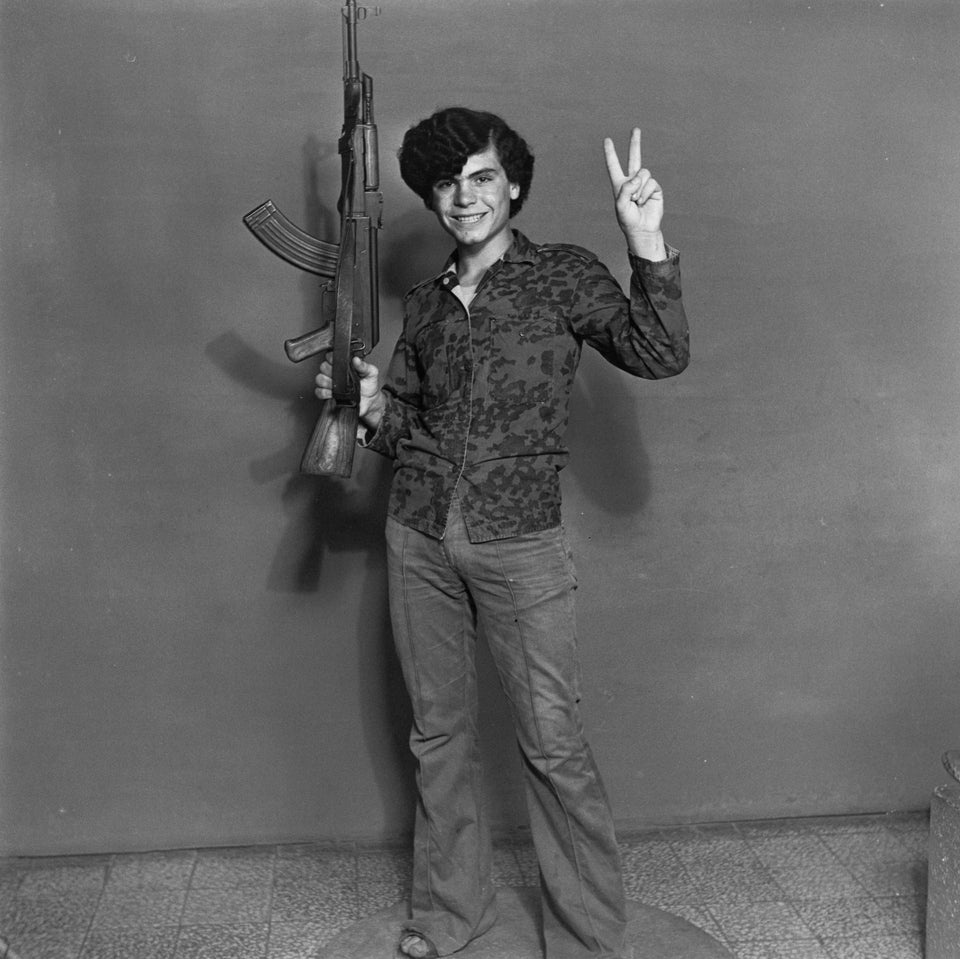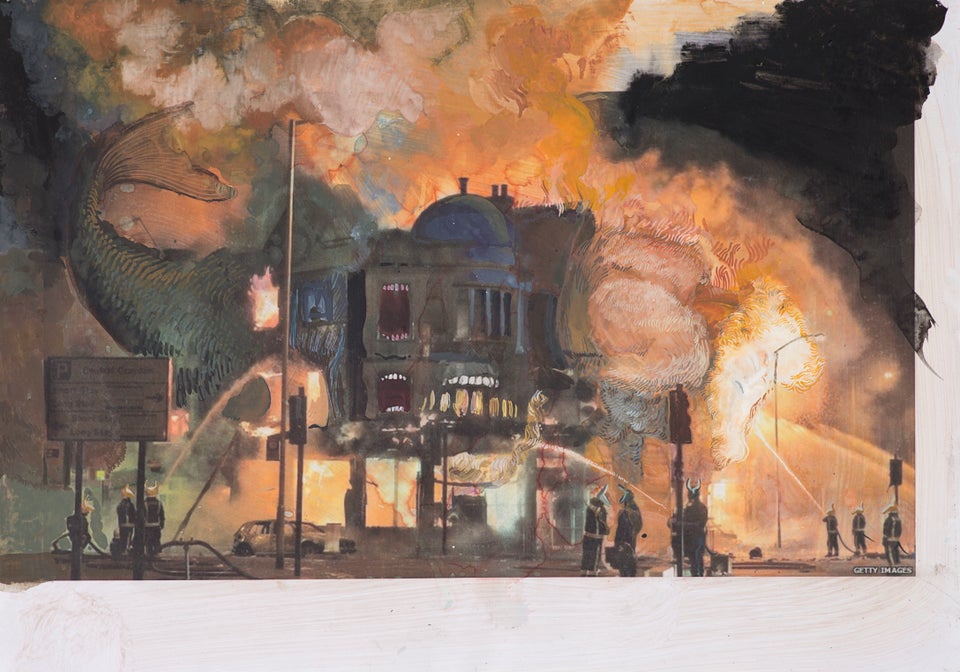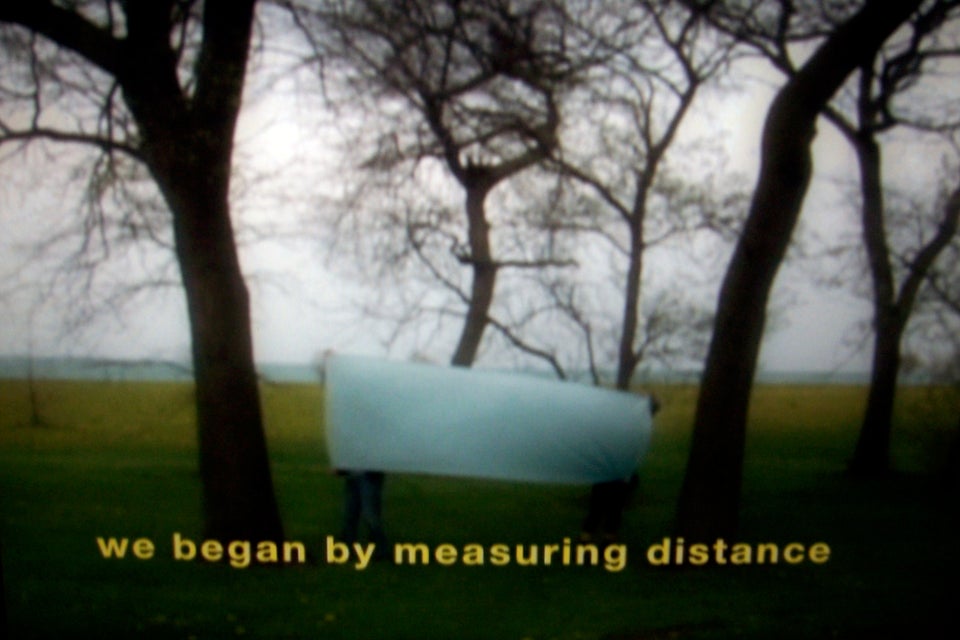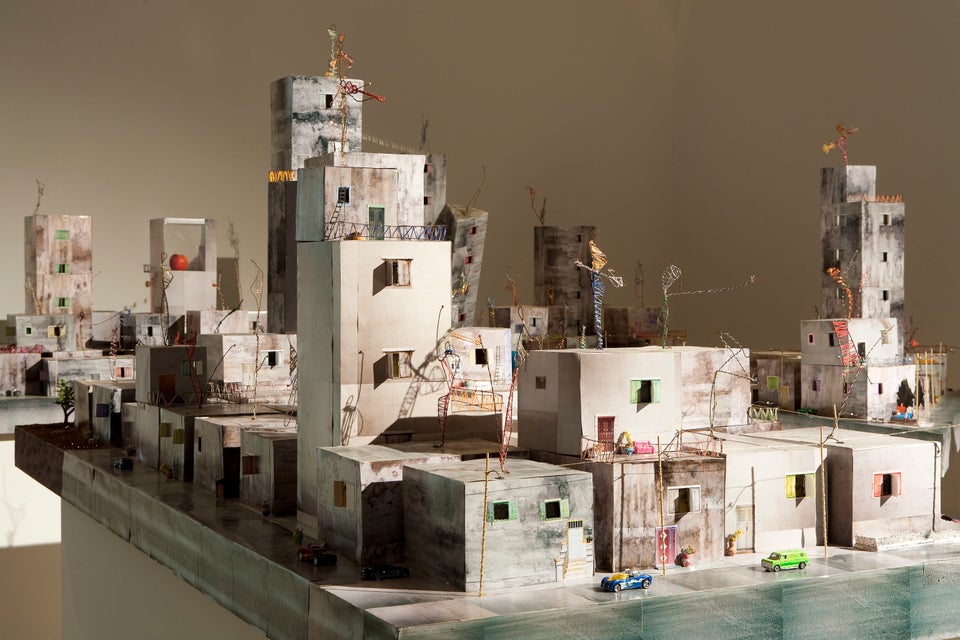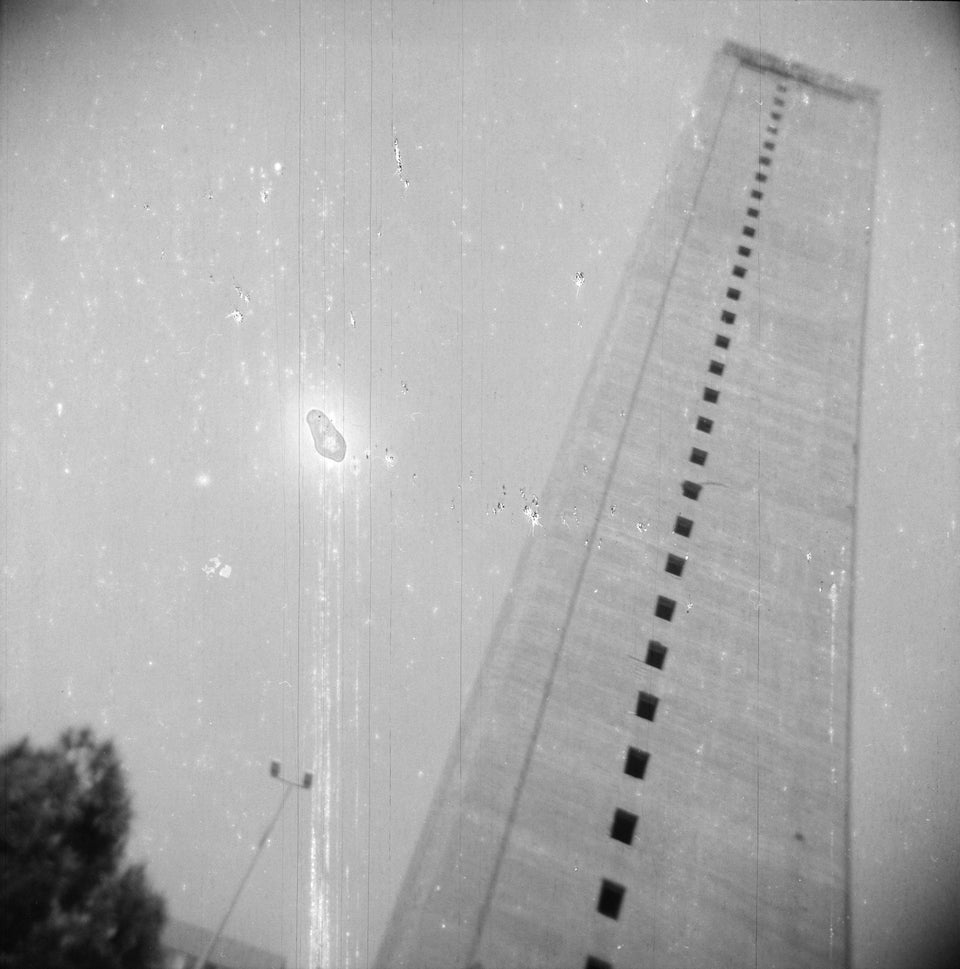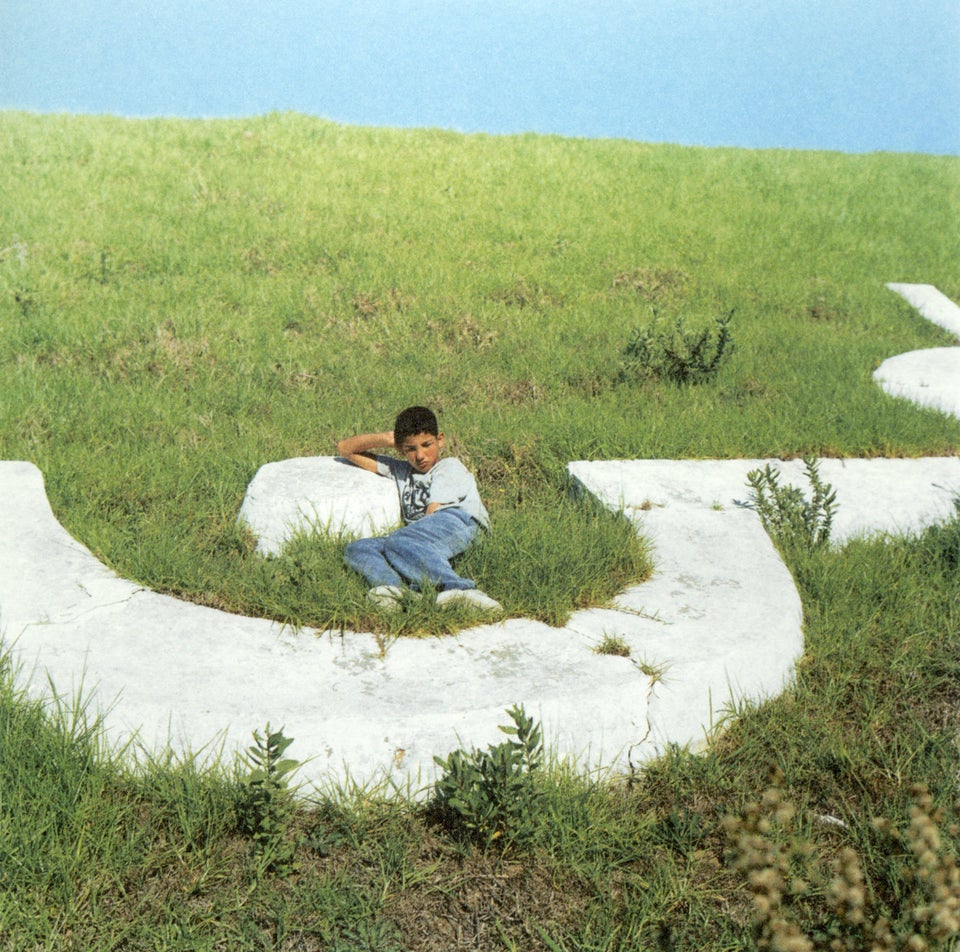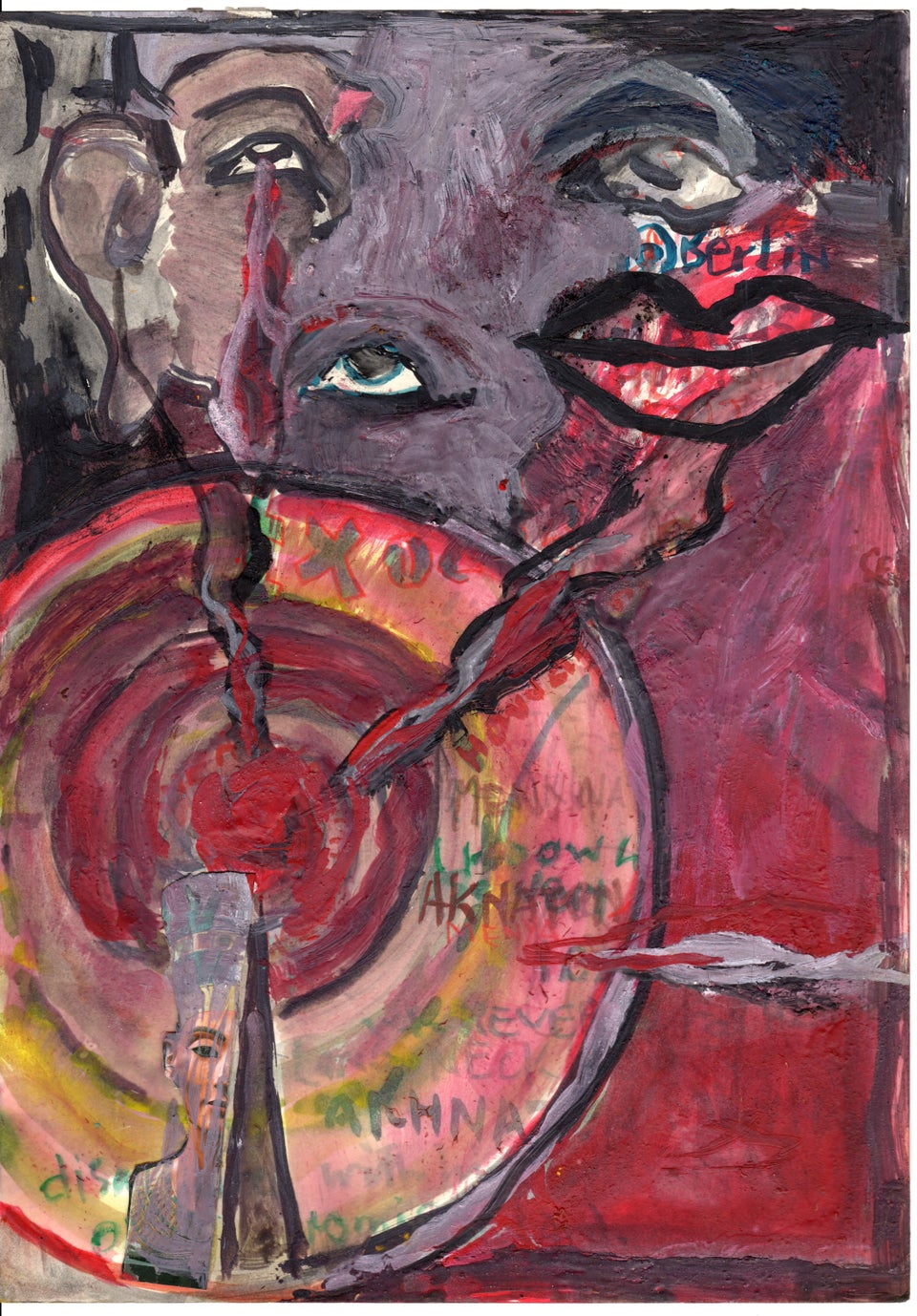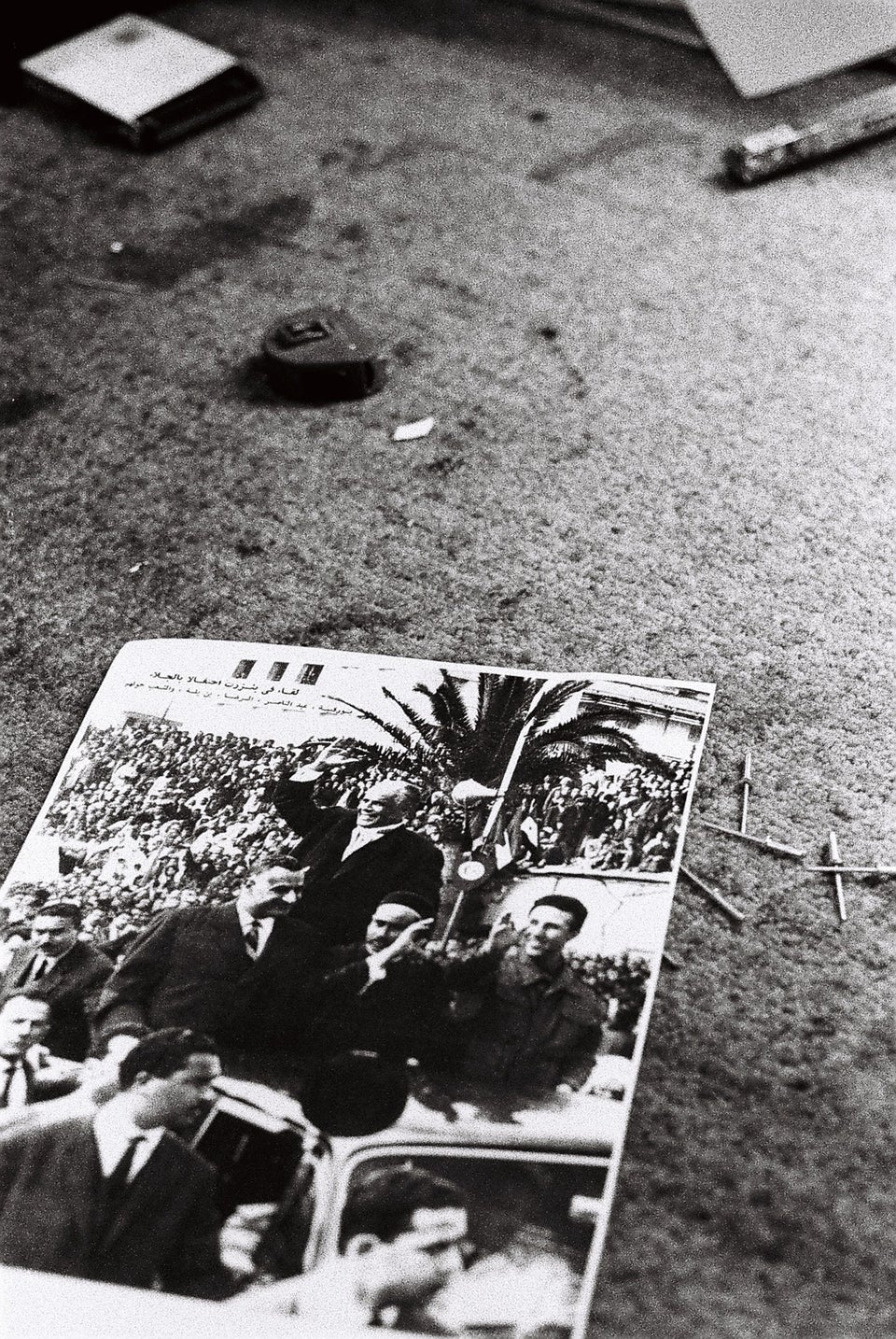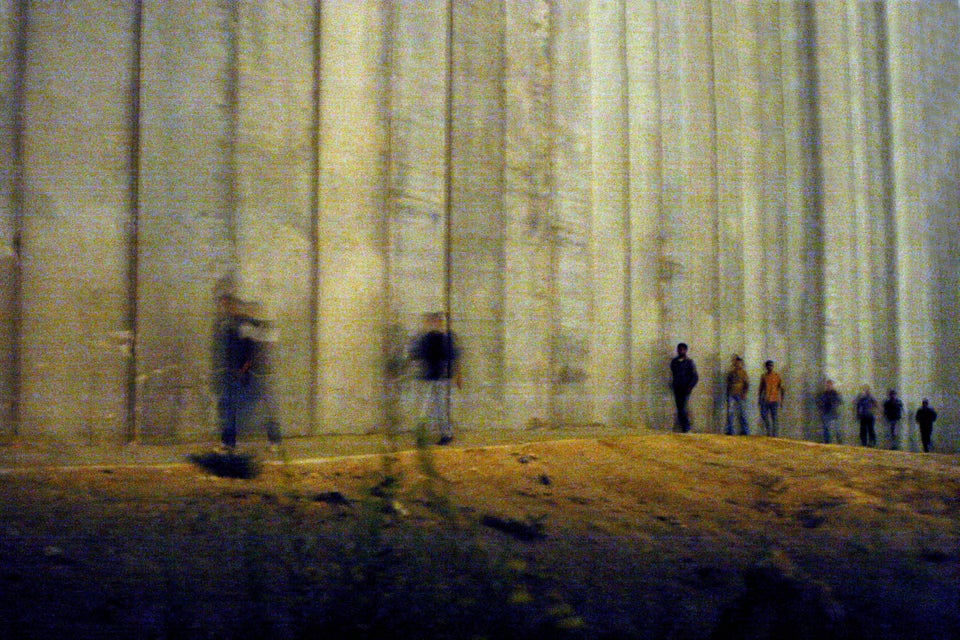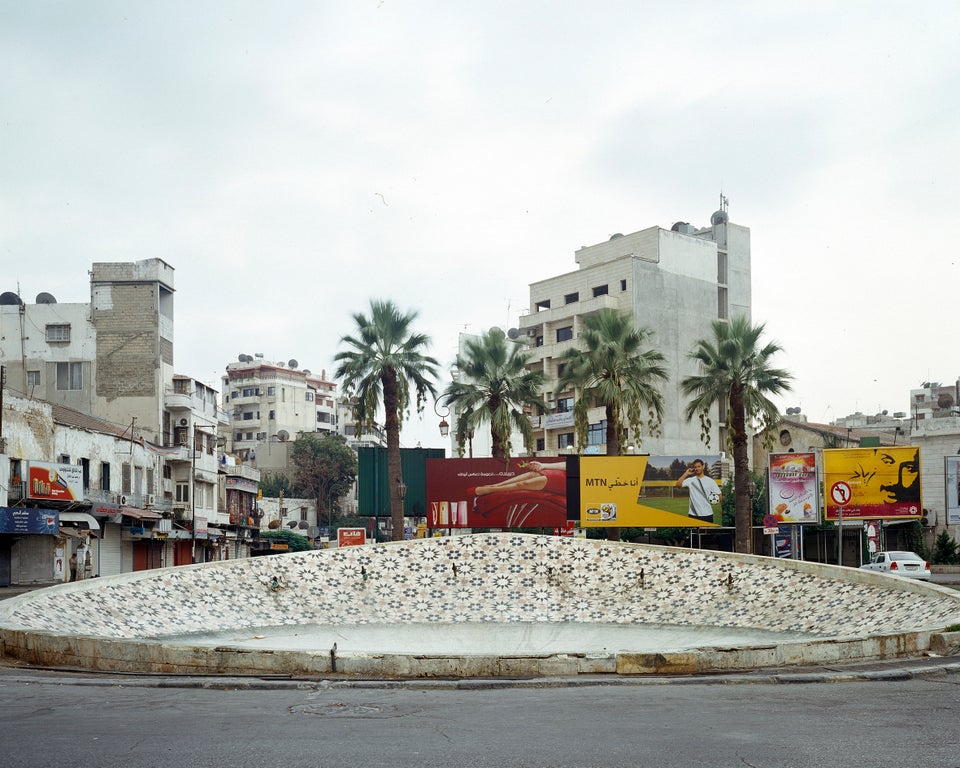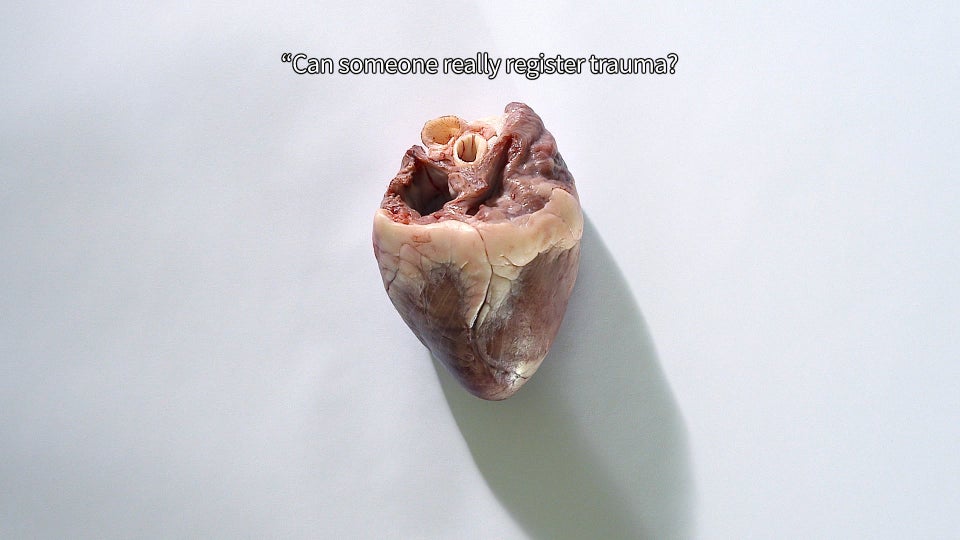A family of tourists pose in front of a monument, gazing into the camera as one unit. A block of white-washed apartments rise up behind a smattering of palm trees. A child lounges on a grassy knoll, paying no attention to the lens pointed at him. These scenes are familiar enough, and seem to cross cultural barriers. They belong to no country or nation in particular, and have probably been enacted in almost every region across the world.
Then you see a bell bottom-clad youth making a peace sign with one hand, holding a rifle in the other. A painted woman brandishing a firearm appears on the cover of an unrecognizable publication. A group of what appears to be protesters flock together with a guitar and a megaphone in hand, fire blazing behind them. Though the images are common to some, they are foreign to others, and only begin to bring a theme into focus. They possess hints of violence, somewhat removed from the more tranquil photographs seen before.
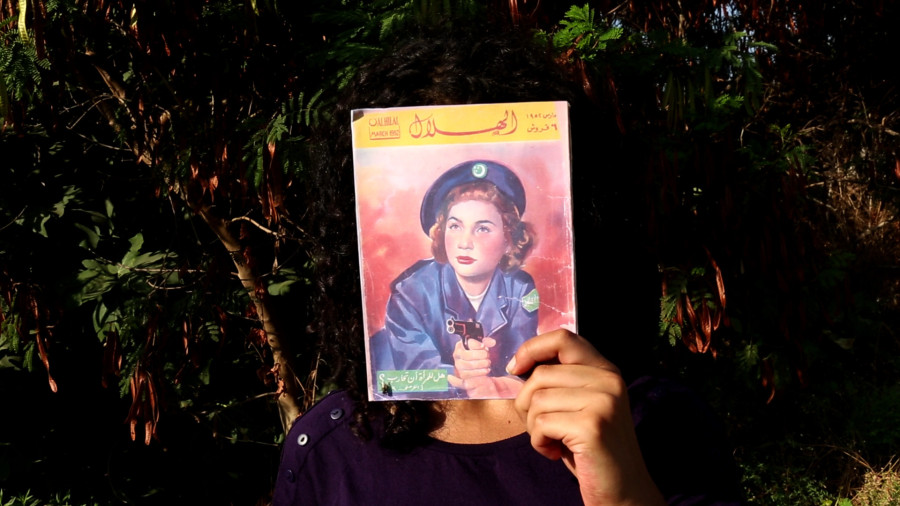
Marwa Arsanios, Have You Ever Killed a Bear? Or Becoming Jamila, 2013–14 (still). Video, color, sound; 28 min. Courtesy the artist
That's the beauty of the New Museum's "Here and Elsewhere" exhibition. A collection of works by contemporary artists from the Arab world, it showcases moments both banal and distinctive. From documentary photographs to abstract painting to video installations, the collection reveals the breadth of media and subject matter present in the art world of countries like Syria, Egypt, the United Arab Emirates and Lebanon. Whether interested in current events, global consumption or everyday life in a city, the works as a whole tease the viewer into a sense of understanding, while revealing the nuances of Middle Eastern culture largely misunderstood by outsiders.
Curated by Massimiliano Gioni and his team, the disparate collection of paintings, sculpture, video and photography by 45 artists from 15 countries steers clear of any regional categorization. While the Iranian artist Rokni Haerizadeh takes stills of broadcasts on YouTube as a point of focus, Beirut-born Mazen Kerbaj showcases his own feverish diary-like drawings. Egyptian painter Anna Boghiguian melds images of pharaohs in an abstract storm while Jerusalem-born Ali Jabri collages detached snapshots in a piece dubbed "Red Sea." The sentiments are as different as the art forms, surveying a portion of the world banded together by territory or tradition, yet capable -- like any other corner of the planet -- of producing wildly diverse imagery and aesthetic.
The rather vague title of the show, based on Jean-Luc Godard's film "Ici et Ailleurs (Here and Elsewhere)," touches on the inherent similarities between these artists and contemporary figures in other countries. It also attempts, perhaps harder than necessary, to avoid attaching any stereotypes or generalizations to the broad survey of cities and movements across the Arab world.
"'Here and Elsewhere'... evades the regionalist trap better than any show I've seen in a while," The Guardian's Jason Farago wrote following the exhibition's opening.
"After decades of postcolonial consciousness raising, we’ve grown leery of shows that lump sundry unalike cultures together," Holland Cotter remarked in The New York Times. "In reality, there’s no right way to go. But if shows like this are the only way, given the provincial nature of the New York art world, that we get to learn about what’s happening across the globe, so be it.
While the quiet name sought to sneak under the radar of controversy, tension wound its way into the New Museum anyway. Ramallah-based Palestinian artist Khaled Jarrar was barred from leaving the West Bank, unable to partake in the opening days of the show. The unfortunate event further emphasized how difficult curating a show like this can be, pulling artists from far-reaching, sometimes ignored spaces under one roof. Take a peek at what "Here and Elsewhere" has to offer and let us know your thoughts on the works in the comments.
Fouad Elkoury -- based in Paris and Beirut
Fouad Elkoury, Color snapshot, Place des Canons (Beirut 1982), 2014. Digital inkjet print, 15 3/4 x 23 5/8 in (40 x 60 cm). Courtesy the artist, the Third Line, Dubai, and Galerie Tanit, Munich/Beirut
Ali Jabri -- born in Jerusalem
Ali Jabri, Red Sea, from the “Nasser” series, ca. 1977– 83. Collage, 7 7/8 x 5 3/4 in (20 x 14.8 cm). Courtesy Diala al Jabiri
Akram Zaatari -- born in Sidon, Lebanon
Akram Zaatari, Hashem El Madani—Palestinian resistant, Studio Shehrazade, Saïda, Lebanon, 1970– 72. From “Objects of study/The archive of Shehrazade/Hashem el Madani/Studio practices,” 2006. Gelatin silver print, 11 1/2 x 11 1/2 in (29 x 29 cm). Courtesy the artist and Sfeir-Semler Gallery, Beirut/Hamburg
Rokni Haerizadeh -- born in Tehran, Iran
Rokni Haerizadeh, Subversive Salami in a Ragged Briefcase, 2014. Gesso, watercolor, and ink on printed paper, 11 3/4 x 15 3/4 in (30 x 40 cm). Courtesy the artist and Gallery Isabelle van den Eynde, Dubai
Basma Alsharif -- born in Kuwait
Basma Alsharif, We Began By Measuring Distance, 2009 (still). Video, color, sound; 19 min. Courtesy Galerie Imane Fares, Paris
Wafa Hourani -- born in Hebron, Palestinian territories
Wafa Hourani, Qalandia 2087, 2009. Mixed media installation in six parts, sound, 216 x 354 in (550 x 900 cm). Nadour Collection, Dusseldorf. Installation view: Haus der Kunst, Munich. Photo: Wilfried Petzi
Ziad Antar -- born in Sidon, Lebanon
Ziad Antar, Murr Tower, Wadi Abu Jmil, Built In 1973, from the “Expired” series, 2009. Gelatin silver print, 19 3/4 x 19 3/4 in (50 x 50 cm). Courtesy the artist and Selma Feriani Gallery, London
Yto Barrada -- based in Tangier, Morocco
Yto Barrada, N du mot Nation en arabe, Tanger (N of the Nation in Arabic, Tangier), 2003. Chromogenic print, 31 1/2 x 31 1/2 in (80 x 80 cm). Courtesy the artist and Sfeir-Semler Gallery, Beirut/Hamburg
Anna Boghiguian -- born in Cairo, Egypt
Anna Boghiguian, Untitled, 2011. Paint and white pencil on paper, 15 3/4 X 11 3/4 in (40 x 30 cm). Courtesy the artist and Sfeir-Semler Gallery, Beirut/Hamburg
Fakhri El Ghezal -- born in Akouda, Tunisia
Fakhri El Ghezal, Retour chez Abdelbasset l'encadreur 1, from the “Chokran ya siédété al raiis” series, 2011. Gelatin silver print, 5 1/2 x 8 1/4 in (14 x 21 cm). Courtesy the artist
Shuruq Harb -- based in Ramallah, Palestinian territories
Shuruq Harb, The Keeper, 2011–13 (detail). Installation with video, includes photographs, wires, clips, and street sign, dimensions variable. Installation view: Darat al Funun, Amman. Courtesy the artist. Photo: Bashar Alaeddin
Khaled Jarrar -- based in Ramallah, Palestinian territories
Khaled Jarrar, Infiltrators, 2012 (still). Video, color, sound; 70 min. Courtesy the artist. © Khaled Jarrar
Hiwa K -- born in Iraq
Hiwa K, This Lemon Tastes of Apple, 2011 (still). Video, color, sound; 13:26 min. Courtesy the artist
Bouchra Khalili -- born in Casablanca, Morocco
Bouchra Khalili, Mapping Journey #7, from “The Mapping Journey Project,” 2008–11 (still). Video, color, sound; 6 min. Courtesy the artist and Galerie Polaris, Paris
Ahmed Mater -- born in Abha, Saudi Arabia
Ahmed Mater, Leaves Fall in All Seasons, 2013 (still). Video, color, sound; 35:20 min. Courtesy the artist and Athr Gallery, Jeddah
Abdullah Al Saadi -- born in Khorfakkan, United Arab Emirates
Abdullah Al Saadi, Camar Cande’s Journey, 2010–11 (detail). 151 watercolour paintings, video, color, sound; 59:41 min, overall dimensions variable. Commissioned by Sharjah Art Foundation. Courtesy the artist. Image: Courtesy Sharjah Art Foundation
Hrair Sarkissian -- born in Syria
Hrair Sarkissian, “Execution Squares,” 2008. Archival inkjet print, 23 3/4 x 30 1/2 in (60.5 x 77.4 cm). Courtesy the artist and Kalfayan Galleries, Athens/Thessaloniki
Mounira Al Solh -- born in Beurit
Mounira Al Solh, Now Eat My Script, 2014 (still). Video, color, sound; 24:50 min. Courtesy the artist and Sfeir-Semler Gallery, Beirut/Hamburg
"Here and Elsewhere" is on view at the New Museum until September 28, 2014. The show was curated by Massimiliano Gioni, Artistic Director; Natalie Bell, Curatorial Associate; Gary Carrion-Murayari, Kraus Family Curator; Helga Christoffersen, Assistant Curator; and Margot Norton, Assistant Curator.
Support HuffPost
Our 2024 Coverage Needs You
Your Loyalty Means The World To Us
At HuffPost, we believe that everyone needs high-quality journalism, but we understand that not everyone can afford to pay for expensive news subscriptions. That is why we are committed to providing deeply reported, carefully fact-checked news that is freely accessible to everyone.
Whether you come to HuffPost for updates on the 2024 presidential race, hard-hitting investigations into critical issues facing our country today, or trending stories that make you laugh, we appreciate you. The truth is, news costs money to produce, and we are proud that we have never put our stories behind an expensive paywall.
Would you join us to help keep our stories free for all? Your contribution of as little as $2 will go a long way.
Can't afford to donate? Support HuffPost by creating a free account and log in while you read.
As Americans head to the polls in 2024, the very future of our country is at stake. At HuffPost, we believe that a free press is critical to creating well-informed voters. That's why our journalism is free for everyone, even though other newsrooms retreat behind expensive paywalls.
Our journalists will continue to cover the twists and turns during this historic presidential election. With your help, we'll bring you hard-hitting investigations, well-researched analysis and timely takes you can't find elsewhere. Reporting in this current political climate is a responsibility we do not take lightly, and we thank you for your support.
Contribute as little as $2 to keep our news free for all.
Can't afford to donate? Support HuffPost by creating a free account and log in while you read.
Dear HuffPost Reader
Thank you for your past contribution to HuffPost. We are sincerely grateful for readers like you who help us ensure that we can keep our journalism free for everyone.
The stakes are high this year, and our 2024 coverage could use continued support. Would you consider becoming a regular HuffPost contributor?
Dear HuffPost Reader
Thank you for your past contribution to HuffPost. We are sincerely grateful for readers like you who help us ensure that we can keep our journalism free for everyone.
The stakes are high this year, and our 2024 coverage could use continued support. If circumstances have changed since you last contributed, we hope you’ll consider contributing to HuffPost once more.
Already contributed? Log in to hide these messages.



